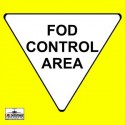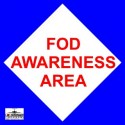Compliments of U.S. Air Force “Flying Safety” Magazine
Aircraft maintenance personnel were tasked with troubleshooting a C-5 #3 engine generator discrepancy. Worker 1 performed the outside walkaround and the required intake/exhaust inspection of all four engines. During the #4 engine inspection he found a nut and washer missing from the fan stopper. The fan stopper is a wooden handle with a heavy rubber tip attached to sheet metal and secured by three screws. He finished the inspection of the #4 engine, then re-inspected the P3 engine to ensure it was clear of FOD. Finding none, he documented the inspections in the aircraft forms. Good work ethic, right?
Worker 1, along with two co-workers, started and warmed up the engines and performed their assigned task. After the run, Worker 1 performed the required post-flight intake inspection, and guess what he found? FOD damage to the #4 engine fan blades and surrounding areas! Where could it have come from?
During the initial investigation a screw was found lodged in the #4 engine fan blade’s second stage outer shroud. This screw matched the two other screws that were installed in the fan stopper handle. IAW T.O. 1C-5A-2-1, the fan stoppers are to be inspected prior to use. However, there is no criteria for inspecting the fan stopper.
How could we have prevented the $350,000+ repair cost and lost mission-capable time of a critical airlift asset? How about closer attention to detail or more defined directions? Or, if you don’t have all the hardware, stop and find out where it went before you start the engines.
Do You Have All the Pieces?
October 30, 2011 by



